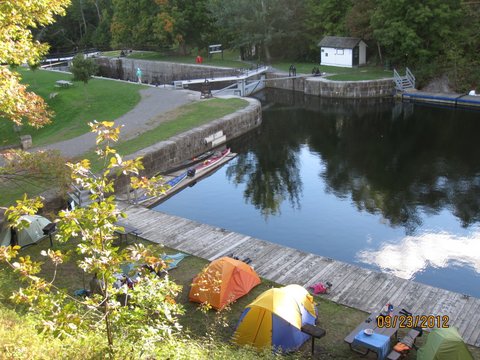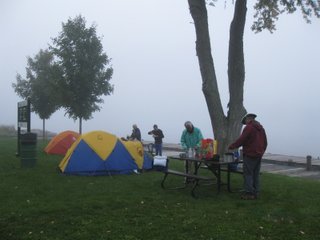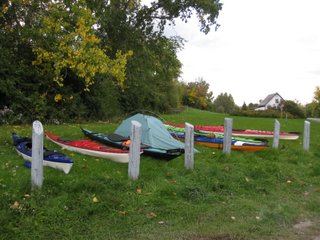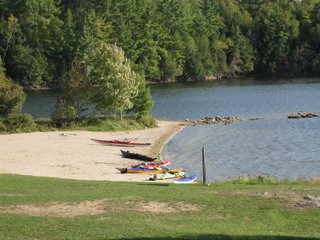by Jim Fitton
 The plan is to navigate our ship up the Rideau Canal Waterway from Kingston to Black Rapids, just south of Ottawa, where some will disembark, while others may continue to the Ottawa River. This performance will be accomplished by a sextet. The three soloists are Blue Caribou, Blue Delta and Teal Khatsalano. There is a duet of Solstices, Red and Green. Then there is the maestro and captain, Red Ellesmere.
The plan is to navigate our ship up the Rideau Canal Waterway from Kingston to Black Rapids, just south of Ottawa, where some will disembark, while others may continue to the Ottawa River. This performance will be accomplished by a sextet. The three soloists are Blue Caribou, Blue Delta and Teal Khatsalano. There is a duet of Solstices, Red and Green. Then there is the maestro and captain, Red Ellesmere.
For my drive down to Kingston, I choose for my listening pleasure Wagner’s Lohengrin, starring our own Ben Hepner. An opera set on and by a river seems to set the tone for our trip. We meet on the Lower Cataraqui River at a marina that has seen better days. It is owned by, Peter, a kind and generous Croatian man who welcomes us to his facility. It is a rainy evening. Three of us camp in our cars, three choose a motel.
After a quick breakfast at the always available Tim’s, we load up. I watch in amazement as my fellow crew work tirelessly to stash the hold with ample food and a superabundance of beverages. But then, it is appropriate that, in the hometown of Canada’s first prime minister, there should be sufficient liquid refreshment aboard to slake even the thirst of Sir John A.
We disembark and are immediately pulling through weeds. This will be a feature of our trip. It is a fine, cool morning as we stroke against the current up the lazy Cataraqui. We see the marshes about us, framed by the still green trees; we see signs of high rock cliffs and even a modest escarpment to our right. I recall that the Shield dips down here as the “Frontenac Axis.” Periodically there are volleys of shotgun blasts from the hunters hidden away in their blinds. We soon see and pass under the busy 401 and shortly after arrive at Kingston Mills.
The giant wooden doors of the first lock beetle over us. Some of us have expressed trepidation about the lock experience, but our wise and experienced captain dismisses our fears. The polite young lockmaster greets us and ascertains that we need passes. He collects monies and card numbers and admits us to the first of this set of four locks. The doors close and we immediately have a small problem. Red Ellesmere would fain float free amidst the swirling waters, but the lockmaster insists that we must all hold the cables which descend vertically on both sides. Our master’s remonstration is fruitless as the lockmaster is adamant. We will all hang on to cables for all 40 of the locks we will negotiate on this trip. With this settled, we pass through the locks, and, at the last one, the efficient and diplomatic lock steward hands us our stickers and receipts.
It is a pleasant first day of travel. We pass over Colonel By Lake and up the oddly named River Styx, which, in ancient times, would only be crossed in the company of Charon, on one’s final voyage into the Underworld. Mercifully, we arrive alive and well at Lower Brewers, the agreed camp spot for our first night. This is a lovely place, where there is an old grist mill and a large marshy lake. Green Solstice hears tell of a local orchard and returns from it with a fresh apple pie, which is generously shared among the crew. I hike there and secure two apples, my last fresh fruit of the week. Two local fishermen offer to bring us back bass from the lake, but return with their catch late in the evening when we are all finished our suppers. A charming feature of the lock is the ancient wooden drawbridge which spans the river. It is a minor country road, but periodically, during the night, we hear the clatter-clatter of cars passing over.
The next day is another pleasant 20-kilometre leg of our voyage. We move down Cranberry Lake and arrive in early afternoon at Jones Falls, where we must wait for a bigger boat to catch up to us before the lock is opened. Here are three locks close together, then a fourth after a bend in the stream. There is a large hotel/restaurant at the approach, and the lockmaster tells us that dinner is available there. Five of us book a table, but the sixth prefers camp food. Our captain decides that two days of paddling have made him unfit for a formal dinner, so he wishes to bathe in the lock. The lockmaster warns him that this is illegal and will result in charges. But the lock staff finish work at 4:30, and therefore none can be found at 4:31. So our intrepid leader descends the steel ladder into the lock and bathes in the waters, commenting on how cool they are. Blue Delta pluckily follows his lead. The only other bather is Khatsalano, who is warned off by the suggestion of cold water, and skulks off to find a spot on a ledge beyond the lock where the water has been warmed by afternoon sunshine. While my fellow crew members are dining out, I hike down and inspect the blacksmith’s shop near the lock. There is also a fortified bunker at the top of the hill overlooking the whole complex. This reminds me of why the Rideau system was built, and recalls a time when relations with our neighbour to the south were less than cordial.
Having completed two good multi-day hikes in the summer in Algonquin Park, I am impressed with how civilized lock camping is. There is always an abundance of mowed grass, there are flush toilets, and the water is potable. These features make for a less demanding tenting experience. My only stricture is that at some locks the big lights are left on, so that you either have trouble drifting off, or you wake up and think it is daylight again.
Next day we pass through a series of small lakes and past Chaffey’s Lock. There are buoys to mark the way for boats, but only where the channel is narrow. The path is tortuous and we need maps to find the correct route. Sometimes the river winds through wide marshes and we take short cuts through the weeds. Often enough, though, this is a fool’s game as we are caught in giant floating mats which make us feel we are paddling on a damp carpet. We are incessantly cleaning weed from the paddles. At one point we come across a swan which is disturbed and must swim off to make way for us. Remembering my opera, I note that it is not towing a boat with a knight in armour. This part of the river reminds us of parts of the Shield, with lovely rocky bays and modest cottages.
There are lots of geese, ducks and gulls, and we see an osprey. We also see lots of osprey nests built on platforms that have been provided for them. One is even on a hydro tower. But what is impressive is what we do not see. No deer, no turtles, no snakes and only two frogs, both hapless critters sheltering in crevices in the lock walls who are rescued by Red Ellesmere. There is no summer abundance of wildlife, for summer has passed.
Again in early afternoon, we arrive at Newboro. Blue Caribou has developed a taste for restaurant fare and disappears to a nearby hotel. Red Solstice and Khatsalano hike into town in the hope of finding either a beer or an ice cream, but find only a clothing store with sale signs outside.
Thus far, we have been ascending steadily on our quest, and we have been confronted at each lock station with tall gates rearing up before us, but facing away from us. When we pass onto Upper Rideau Lake, we are at the height of land for our trip. The next lock, Narrows, is eerily different than those we have encountered. We can look past the lock gate and down onto the water ahead.
We pass now onto Big Rideau Lake. Up to this point, the trip has been through small lakes and we have travelled in a northeasterly direction. Now we shall be paddling the biggest of the lakes and will be travelling eastwards for the next two days or so. An east wind would pose difficulties. Mercifully, we have a goodly southwest wind, which provides considerable help, although it tends to quarter us from the right at our backs. It is choppy, and there are good waves. Nevertheless, we make good time, and, in early afternoon, pull into Murphy’s Point Provincial Park. Unsure of the precise location of good campsites, we are helped by advice from a couple who arrive by boat at the boat launch shortly after we do. The man is friendly and garrulous and tells us that he has a cottage located nearby on the park property. He does manage to let slip also that he has 1200 square feet of glass in his windows. (Egad! I think, more than the entire floor space of my house on the Bruce.) We also learn that he and his wife have three boats, and that their cottage furnace has “clicked on” this morning. His wife apologizes that they are “wimps.” As they leave, Green Solstice comments ironically on the gentleman’s shabby appearance. We do notice, however, that large and luxurious cottages are a feature of this part of the trip.
We locate a car camping site near the main beach and set up among the trees. It is a glorious afternoon. It is the fourth day and time for me to wash again. I bathe at the beach and wash my paddling clothes, hanging them on a tree to dry. I sit in the sun for over an hour, reading. Another crew member, who has neglected to bring a swimsuit, bathes in underwear. The feeling of bliss is a high point of the trip for me. In the evening we have a wood fire, courtesy of Caribou who has thoughtfully secured two bundles of wood while hiking to the main gate to pay for our campsite.
Tomorrow will be a longer day with 27 kilometres to traverse, and seven locks. The lock time must always be factored into the day’s schedule, as it can involve a wait of up to 25 minutes before entering the lock if there is traffic in the opposite direction, and then each individual lock can take up to 15 minutes. The lock stations close at 3:00 or 4:00, depending on the day, and we want to arrive early enough so as to pass through the locks at the destination and thus be able to leave early the next day. We have calculated that we will need to leave by 8:00, and will need to be up before 6:00 to accomplish this.
Our trusty early bird, Caribou, is the wake-up man. Sure enough, my tent is shaken at 5:45, and we are all up, headlamps in place to guide us between the trees. All proceeds well and we are on the water at the agreed time. The tail wind persists, and we fly down to Smiths Falls. The approach to this pretty town is over a wide marshy lake. As we near the town, I am bemused by the sight of an old railway drawbridge which is open and seemingly fixed in place at an angle of about 75 degrees. The lockmaster at the first lock tells me that the bridge is an old teeter-totter design which operated up until the late 1970s. It was apparently a common railway design in the American mid-west at one point. Truly an unforgettable sight.
A word about the locks themselves. Most of the locks raise or lower the water about 8 or 9 feet. They are mostly manual, too, to preserve the historical nature of the system. The lock staff must crank up four sluices at each set of doors to allow water to pass, and then the doors are opened by crank mechanisms. It is surprising that, with all this work, many of the lock staff seem to have BMIs above the average!
We are now in the central lock at Smiths Falls, mysteriously titled “Combined” and we notice that it is hydraulic, so the water quickly empties into the river ahead, and we descend, and descend and descend. Memories of Edgar Allan Poe’s story “The Descent into the Maelstrom” trickle into my mind, and I nervously inquire as to the depth of this lock. Twenty-six feet! It is truly a journey downwards. But we now learn the reason for this lock’s name. Apparently, there were previously three locks in town, and the decision was made to redirect the canal’s path and to replace the three with this one.
We pass beyond the last lock and see our first big buildings for some time, including a Comfort Inn. We do notice that the trees are sporting their fall colours and we wonder if we have now entered a different climate zone. The river turns under a high railway bridge and we are soon at our destination, Edmonds, where we are kept waiting for some time as a cruise boat is coming through. It seems that our sextet must always play second fiddle to the big stars on this trip. This is not far from town, but the lock has a rural feel. Caribou has decided to seek food in town and calls a cab. Other crew members have a brochure promising free delivery of pizza. We order two pizzas and these supplement our camp food.
At each lock station there is a washroom, and, according to the lockmaster’s judgement, this may be locked or left unlocked. It is something to be considered when travelling, because, if you are going to arrive after the departure time of the staff from the lock, you may not be able to access the facility. On more than one occasion we have phoned ahead to alert the lock staff to leave the washroom open. At this lock, we are each issued with a personal key. On our departure next morning, one of these is missing, and we will be nagged at successive locks about this with inquiries as to whether the missing key has shown up. Eventually, the inquiries cease, either because the key has been discovered at the original lock, or because other more pressing matters have intervened.
We are facing another 27-kilometre paddle with 8 locks, so we must again be up early. This time we rise at 5:30, but it is a moonlit morning with no trees overhead, so we have less need of our headlamps. We arrive late morning at the first lock at Merrickville and we wait and wait and wait. No sign of the staff. Finally, Green Solstice disembarks and follows the path across a busy road down to the third of the three locks, to wake up the somnolent staff. The lockmaster appears and our captain pointedly asks why he has kept us waiting for at least 25 minutes. He is defensive, with ill-suppressed irritation. His comment that “you are not the only boats on the river” almost prompts me to reply that we have very nearly have achieved that status, based on what I have seen so far. He tells us that they have been waiting for a houseboat headed upstream towards us.
Nevertheless, this does not appear, and we are allowed to pass through the locks and we sit down beside the last of these to lunch. We are entertained by the antics of the aforementioned houseboat which seems to be moving in every direction but the lock. Finally, the luckless skipper steers towards us and I am in some anxiety as to the fate of our craft, moored by the entrance to the lock. Luckily, the houseboat passes us and enters the lock without incident. We leave, and by mid-afternoon, we are camped at Burritts Rapids.
This lockstation is on an island. The approach is marked by an ancient swivel bridge. There is a hiking trail into the eponymous small town, and there is a restaurant right by the lock. Caribou heads over to sample the offerings shortly after setting up. Delta and Khatsalano hike into town in search of store reputed to be there, but are told that it has been long gone. The group decide to dine at the restaurant, and many a good ale is downed in the evening, which fuels the mirth and conversation. Delta confides to us that he is in the habit of “eating people’s minds” to which Red Solstice comments, “You must get very hungry sometimes.” It is dark when the group returns to bed down for the night. We make our way nervously over the peculiar catwalks that form the only pedestrian path over the locks.
We rise with the sun and are greeted by frost on the fields and the rooftops. This makes negotiating the only path to the washrooms perilous. My surf sandals, my only footgear, seem inadequate to the season. I do, however, have fleece gloves, so I can cook my porridge. After two days of very early rises and longish paddles, we are all looking forward to the 20-kilometre trip to Kars where our leader has booked us a spot at a youth camp. It is again a pleasant morning on the river. We stop at Rideau River Provincial Park for lunch, and we do notice that the sandy beach must be approached through a metre-wide band of foul-smelling pond scum. Our journey now turns us northwards, and as we continue, we notice that the river banks show signs of the same condition. Since the camp we are looking for has no sign and no known boat launch, we locate it by counting the buoy numbers. We notice that there is no easy access to the promised site from the river. We also hear the whoops of teenage girls who seem to be present in large numbers. Finally, we are able to summon camp staff, who have no knowledge of the camping arrangement made by phone. They indicate an alternative site nearby, but when we alight, there is a sign indicating that there is to be no camping there. What to do?
Our leader calls a meeting. No one is happy about trying to drag our equipment through sludge to shore and then share our site with noisy youngsters. On the other hand, the alternative is to paddle another 20 kilometres to Long Island Locks. After some discussion, however, it is decided to tackle the 40 kilometre paddle, and to forge on. We move on, and the hours drag. (I must say that this is the longest distance I have paddled in a day, and I become very fatigued towards the end.) There are a couple of short stops, but we essentially cover this leg without a real break. Green Solstice finds the paddling easier when the discussion is of “things that make me mad, like huge cottages, expensive boats…” We arrive at Long Island well after the time for admission has passed, but we do see a lock employee cranking the swivel bridge by hand. It is too late to dry out our tents from the morning dews, so we must be content with making supper and hunkering down for the night.
The lockstation is a busy spot. Anglers are numerous, as are dog walkers. My sleep is punctuated by the sounds of geese flying overhead late at night, but sleep I do after the day’s exertions. Next morning we are faced with a dilemma. The original end point of the trip was to be Black Rapids, a mere 10 kilometres downstream. But, by dint of yesterday’s protracted effort, we have shaved a day off our schedule. What to do? We decide we shall proceed into Ottawa and stop at Hartwells. As we pass Black Rapids, we see virtually for the first time, other paddlers on the river. There are day kayakers, canoeists, and even competition paddlers on their training skiffs. Soon we are at Hog’s Back and see the source of some of these craft: the Rideau Canoe and Kayak Clubhouse. We are held up at the approach to this lock. Our ever intrepid leader enters the lock and is peremptorily ordered out by the surly lockmaster as he stops road traffic at the bridge and lets two large boats through. By early afternoon we are right in Ottawa and the canal is here a true canal for the first time. Yet, despite the high rise buildings, there is still a sense of rusticity because we are adjacent to the university’s experimental farm with its trees and fields.
It is wonderful to be in our nation’s capital and to enjoy its ambience for a short time. There is an abundance of green space and trails with joggers and cyclists. In the space of a few minutes I see a recumbent bike and a tandem bike. I have never seen either in Newmarket. Then there are the multitudinous dog walkers. I have heard it said that Ottawa in winter is a “dark, damp hole,” but I can say that there are few better places to be on a fine fall afternoon than a campsite on the Rideau in downtown Ottawa.
It is again a sunny afternoon and I wash my clothes in the lock and hang them to dry over an old iron gate. Then I walk over to the Carleton campus and locate a pay phone to tell my wife that I will be home tomorrow. I also locate a razor and shaving gel in the bookstore with which to remove my week’s growth. A ride has been arranged back to Kingston for 5:00 and by 9:00 we are all back in Ottawa for our final night of camping. Of the group, only Blue Delta will complete the trip by descending the last 8 locks and 80 feet to the Ottawa River.
This has been one of the best GLSKA trips I have yet participated in. Our leader was exceptional: he had planned meticulously, and provided excellent leadership on the trip, both by showing sensitivity to the varied personalities of his crew, and by modelling good paddling and camping skills. Our company was very well matched in personalities and skill level. The history and natural beauty of the trip with the wildlife and the fall colours also provided much to enjoy. I would thoroughly recommend this route to other kayakers, but with the caveat that it is probably most enjoyable in the “shoulder months” when boat traffic declines, and competition for camping spots and a place in the locks will be less intense.



